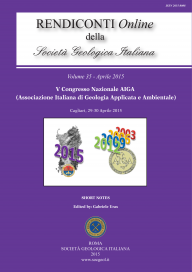
Experiment of an innovative nanoseismic monitoring applied to gravity-induced slope instabilities in a karstified rock mass
Matteo Fiorucci (a), Roberto Iannucci (a), Luca Lenti (b), Salvatore Martino (a) Antonella Paciello (c), Alberto Prestininzi (a) & Stefano Rivellino (a)
(a) Sapienza Università di Roma - Dipartimento di Scienze della Terra e Centro di Ricerca CERI - Piazzale Aldo Moro, 5, 00185, Roma, Italia. E-mail: matteo.fiorucci@uniroma1.it.
(b) Institut Français des Sciences et Technologies del Transports, de l'Aménagement et des Réseaux (IFSTTAR-Paris).
(c) Agenzia Nazionale per le nuove tecnologie, l'energia e lo sviluppo economico sostenibile (ENEA-Casaccia) - Via Anguillarese, 301, 00123, Roma, Italia.
Volume: 35/2015
Pages: 132-135
Abstract
The Peschiera Springs slope (RI), which hosts the drainage plant of the Rome's aqueduct, is affected by a gravitational slope deformation process, that is responsible for a rock-mass lateral spreading, associated to several landforms including sinkholes, subvertical scarps and trenches. An experiment, based on an innovative method of monitoring, was carried out to record microseismic events generated by underground instabilities such as failures and collapses. At this aim a SNS (Seismic Navigation System) array was installed during the year 2013 inside a the tunnel of the drainage plant in order to carry out a continuous monitoring. The nanoseismic monitoring, allowed to record 37 microseismic events. The seismic records were managed by NanoseismicSuite software that allowed to identify and characterize two different typologies of events: 19 underground collapses and 18 underground failures. The locations of these events are in good agreement with the evolutionary geological model of the ongoing gravitational slope deformation, i.e. with the spatial distribution of the main trenches and scarps on the slope.
Keywords
gravity-induced slope deformations, seismic monitoring, underground collapses, underground failures.
Get Full Text